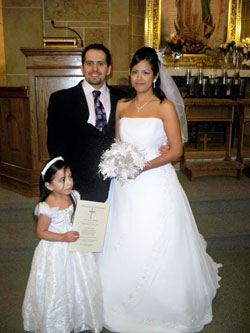Saying ‘I do’ again: Hispanic couples convalidate civil marriages in Church ceremony

Idelfonso Orlando Mondragon Garfias and Leticia Calderon Anzures pose for a wedding photograph with their 3-year-old daughter, Michelle, after their 2005 civil marriage in Mexico was convalidated in the Church during an Oct. 31 nuptial Mass at St. Philip Neri Church in Indianapolis. They were among seven Hispanic couples who were married during the same liturgy. (Submitted photo)
By Mary Ann Wyand
It was a historic—and romantic—liturgy.
Idelfonso Orlando Mondragon Garfias and Leticia Calderon Anzures were among seven Hispanic couples who were married during a nuptial Mass on Oct. 31 at St. Philip Neri Church in Indianapolis.
The two-hour wedding liturgy marked the first time in the 100-year history of St. Philip Neri Parish that so many couples exchanged marriage vows during the same Mass.
Their marriage vows in the Catholic Church convalidated earlier civil ceremonies in Mexico, and enabled them to receive the Eucharist and other sacraments.
“We have a number of couples in our parish who are Hispanic, and who have either been married civilly or simply living together for a number of years,” explained Father Carlton Beever, the pastor of St. Philip Neri Parish. “We have begun receiving them into the Church and formalizing their marriages sacramentally. We had seven weddings in one ceremony as part of that process.”
The brides wore white dresses and carried flowers. More than 400 relatives—including children of the couples—and many of their friends participated in the Mass.
“One couple had been together for 20 years,” Father Beever said. “They had been married civilly, but never married in the Church. I don’t think it’s unique to our parish that some of the immigrants who are coming to the United States are trying to normalize their marriage vows. … They want to be a good example for their children and participate more fully in the Church.”
In Mexico, couples are required to be married in a civil ceremony first then may participate in a Church wedding.
“In lots of cases, this is impossible because people can’t afford it,” Father Beever said. “So we have lots of situations, as do other parishes with Hispanic members, where they have couples who have never been married in the Church and can’t receive the sacraments.”
Roberto Marquez Barruelas, the pastoral associate for Hispanic ministry at St. Philip Neri Parish, recently started a FOCCUS (Facilitating Open Couple Communication, Understanding and Study) marriage preparation program for Spanish-speaking couples.
Fifteen couples from several parishes responded to the announcement of the first marriage preparation program earlier this year. Eight of those couples will be married in the Church during nuptial Masses at other parishes.
“Sometimes the [Hispanic] people ask me if it is possible to have a good marriage because most of the people don’t have the sacrament, only the civil ceremony,” Marquez said. “They have a necessity and desire to be in full communion with the Church.”
There is no charge for the six-month marriage preparation program, retreat day and nuptial Mass, Marquez said, and he hopes more Hispanic couples will want to have their marriages normalized in Catholic ceremonies.
“Now I have five more couples who are interested in doing this after the eight couples,” he said. “I received calls from St. Monica and St. Lawrence [parishes in Indianapolis] and St. Joseph [Parish] in Shelbyville. This opportunity is for all people, not only for [couples in] this parish.”
Ilfonso Mondragon Garfias and Leticia Calderon Anzures were married in a civil ceremony on May 21, 2005, in Mexico City. They immigrated to the United States later that year and are the parents of two daughters, Michelle, who is 3, and Vanessa, who is 10 months old.
Before their Church wedding, they prayed for a happy life together and thanked God for many blessings.
“We already had children,” he said. “We want to teach our children the Catholic faith. I think it’s important for us to be fully married so we can teach our children. That was in our minds.” †
